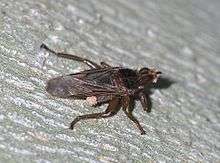Hippoboscidae
| Hippoboscidae | |
|---|---|
 | |
| The flightless Crataerina pallida | |
| Scientific classification | |
| Kingdom: | Animalia |
| Phylum: | Arthropoda |
| Class: | Insecta |
| Order: | Diptera |
| Section: | Schizophora |
| Subsection: | Calyptratae |
| Superfamily: | Hippoboscoidea |
| Family: | Hippoboscidae Samouelle, 1819 |
| Subfamily | |
| Synonyms | |
|
Hypoboscidae (lapsus) | |
Hippoboscidae, the louse flies or keds are obligate parasites of mammals and birds. In this family there are winged species which can fly at least reasonably well, as well as others with vestigial or no wings which are flightless and highly apomorphic. As usual in their superfamily Hippoboscoidea, most of the larval development takes place within the mother's body, and pupation occurs almost immediately.[2]

The sheep ked, Melophagus ovinus, is a wingless, reddish-brown fly that parasitizes sheep. The Neotropical deer ked, Lipoptena mazamae, is a common ectoparasite of white-tailed deer (Odocoileus virginianus) in the southeastern United States. Both winged and wingless forms may be seen. A common winged species is Hippobosca equina, called "the louse fly" among riders. Species in other genera are found on birds, for example, Ornithomya bequaerti has been collected from birds in Alaska. Two species of Hippoboscidae – Ornithoica (Ornithoica) podargi and Ornithomya fuscipennis are also common parasites of the tawny frogmouth (Podargus strigoides) of Australia.
Pseudolynchia canariensis is commonly found on pigeons and doves, and can serve as the vector of pigeon malaria. There is some evidence that other Hippoboscidae can serve as vectors of disease agents to mammals.
Systematics
In some obsolete taxonomies, the name Hippoboscidae is applied to the group properly known as Pupipara, i.e. the present family plus the bat flies (Nycteribiidae and "Streblidae"). It has been shown that two of the three traditional subfamilies (Hippoboscinae and Lipopteninae) are good monophyletic groups at least by and large. According to cladistic analysis of several DNA sequences, to make the Ornithomyinae monophyletic their tribe Olfersini deserves to be recognized as a full-blown family too.[3][4]
- Subfamily Ornithomyinae Bigot, 1853
- Genus Allobosca Speiser, 1899 (1 species)
- Genus Austrolfersia Bequaert, 1953 (1 species)
- Genus Crataerina von Olfers, 1816 (8 species)
- Genus Icosta Speiser, 1905 (52 species)
- Genus Microlynchia Lutz, 1915 (4 species)
- Genus Myophthiria Róndani, 1875 (13 species)
- Genus Olfersia Leach, 1817 (7 species)
- Genus Ornithoctona Speiser, 1902 (12 species)
- Genus Ornithoica Róndani, 1878 (24 species)
- Genus Ornithomya Latreille, 1802 (29 species)
- Genus Ornithophila Róndani, 1879 (2 species)
- Genus Ortholfersia Speiser, 1902 (4 species)
- Genus Phthona Maa, 1969 (3 species)
- Genus Proparabosca Theodor & Oldroyd 1965 (1 species)
- Genus Pseudolynchia Bequaert, 1926 (5 species)
- Genus Stilbometopa Coquillett, 1899 (5 species)
- Subfamily Hippoboscinae
- Genus Hippobosca Linnaeus, 1758 (7 species)
- Genus Struthibosca Maa, 1963 (1 species)
- Subfamily Lipopteninae
- Genus Lipoptena Nitzsch, 1818 (30 species)
- Genus Melophagus Latreille, 1802 (3 species)
- Genus Neolipoptena Bequaert, 1942 (1 species)
See also
References
- ↑ Maa, T. C. (1969). "A Revised Checklist and Concise Host Index of Hippoboscidae (Diptera)" (PDF). Pacific Insects Monograph. Honolulu: Bishop Museum, Honolulu, Hawaii. 20: 261–299.
- ↑ Hutson, A.M (1984). Diptera: Keds, flat-flies & bat-flies (Hippoboscidae & Nycteribiidae). Handbooks for the Identification of British Insects. 10 pt 7. Royal Entomological Society of London. p. 84.
- ↑ Petersen, Frederik Torp; Meier, Rudolf; Kutty, Sujatha Narayanan; Wiegmann, Brian M. . (October 2007). "The phylogeny and evolution of host choice in the Hippoboscoidea (Diptera) as reconstructed using four molecular markers.". Molecular Phylogenetics and Evolution. 45 (1): 111–122. doi:10.1016/j.ympev.2007.04.023. PMID 17583536.
- ↑ Dick, C. W. (20 December 2006). "Checklist of World Hippoboscidae (Diptera: Hippoboscoidea)" (PDF). Chicago: Department of Zoology, Field Museum of Natural History.
External links
| Wikimedia Commons has media related to Hippoboscidae. |
- [Jackson S. Whitman; Nixon Wilson (April–June 1992). "Incidence of Louse-flies (Hippoboscidae) in Some Alaskan Birds" (PDF). North American Bird Bander. 17 (2): 65–8.
- Sheep Ked
- Pigeon Louse Fly
- Pseudolychia canariensis as Vector of Pigeon Malaria
- Halos L, Jamal T, Maillard R, et al. (October 2004). "Role of Hippoboscidae flies as potential vectors of Bartonella spp. infecting wild and domestic ruminants". Appl. Environ. Microbiol. 70 (10): 6302–5. doi:10.1128/AEM.70.10.6302-6305.2004. PMC 522062
 . PMID 15466580.
. PMID 15466580. - Photograph of A Louse Fly
- Images from Diptera.info.
- Images from BugGuide
- Pseudolychia canariensis, pigeon louse fly on the UF / IFAS Featured Creatures Web site
- Lipoptena mazamae, Neotropical deer ked on the UF / IFAS Featured Creatures Web site